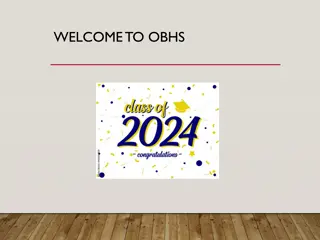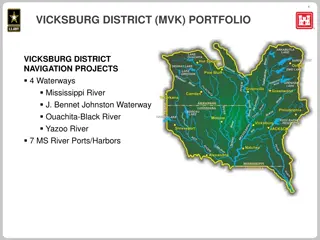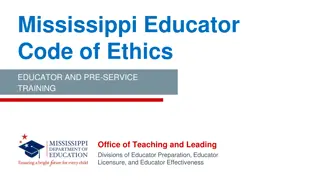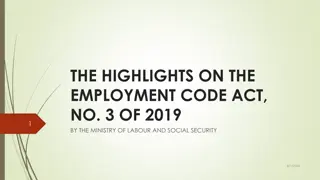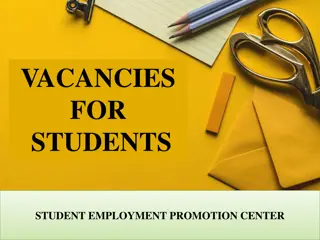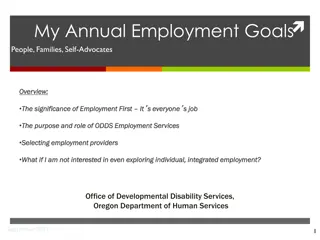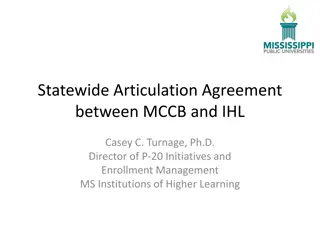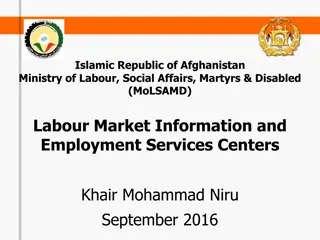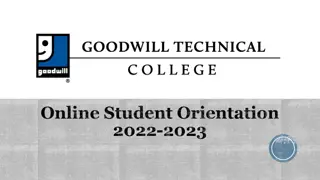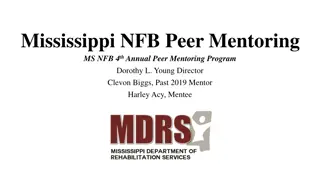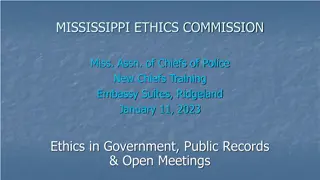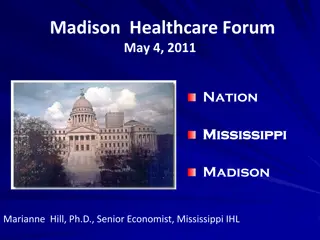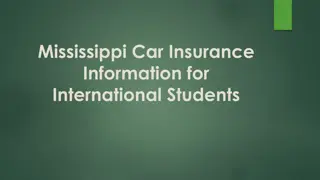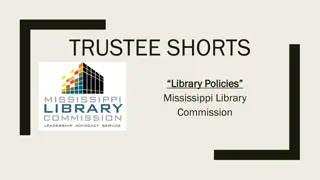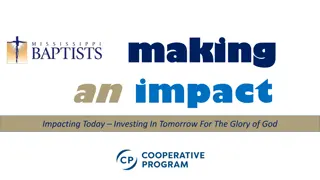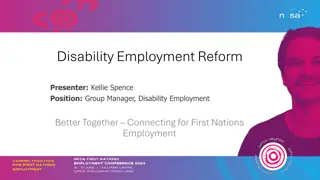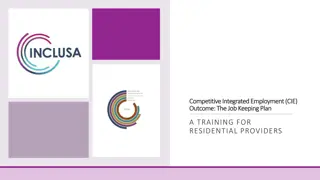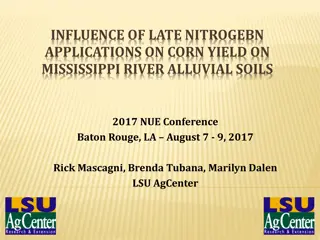International Student Employment Information at Mississippi College
Employment information for international students at Mississippi College includes restrictions on F-1 and J-1 students working on and off-campus, work permission options like Curricular Practical Training and Optional Practical Training, volunteering considerations, and obtaining a Social Security number for employment purposes. The Office of Global Education provides assistance in navigating these processes.
Download Presentation

Please find below an Image/Link to download the presentation.
The content on the website is provided AS IS for your information and personal use only. It may not be sold, licensed, or shared on other websites without obtaining consent from the author. Download presentation by click this link. If you encounter any issues during the download, it is possible that the publisher has removed the file from their server.
E N D
Presentation Transcript
MISSISSIPPI COLLEGE MISSISSIPPI COLLEGE INTERNATIONAL STUDENT INTERNATIONAL STUDENT EMPLOYMENT INFORMATION EMPLOYMENT INFORMATION
Employment for F-1 and J-1 students is limited, and working without permission is a violation of status and a deportable offense. F-1 and J-1 students may not work off-campus without permission from the Office of Global Education. On-Campus Employment is permitted with certain restrictions. Students must complete employment paperwork with the Office of Global Education in order to work on-campus. A Social Security number is required for anyone receiving payment. The Office of Global Education can assist you with this process.
Off Off- -Campus Work Permission Campus Work Permission for F Students Students for F- -1 1 Curricular Practical Training (CPT): This is usually an internship and must be an integral part of the curriculum. Optional Practical Training (OPT): Most student s use this benefit after they graduate, but OPT can be used prior to graduation. Economic Hardship: This work permission can only be used when a student's financial situation drastically changes due to an unforeseen circumstance. Internship with an International Organization: This option allows students to work with the United Nations or World Health Organization, among others.
Off Off- -Campus Work Permission Campus Work Permission for J Students Students for J- -1 1 Academic Training: This benefit allows students to work related to their degree program during or after their studies. Economic Necessity: This work permission can only be used when a student's financial situation drastically changes due to an unforeseen circumstance.
Volunteering Volunteering If you plan to volunteer please make sure you understand what it entails, as it may be viewed as employment. Please check with the Office of Global Education if volunteering on a regular basis. This does not apply for a one-time event.
Social Security Social Security The social security number is used for employment purposes in the United States in order to report wages to the government. The Social Security Administration (SSA) will issue a social security number for employment purposes only. If you have problems in establishing a bank account, renting an apartment or opening a cell phone account, see the International Student Adviser in the Office of Global Education. We can help you find other ways to satisfy the requirement with the agency requesting the number.
The Social Security Administration will require that you prove your identity, age, immigration status, and eligibility to work. In addition, F-1 students must provide evidence of on-campus employment from the campus department and verification of enrollment status from the Office of Global Education. J-1 students must provide evidence of employment eligibility from the sponsor: if Mississippi College issued the DS-2019, the Office of Global Education will issue the letter; if a programming agency such as IIE or AMIDEAST issued the DS-2019, that agency must issue the letter. SSA regulations require two letters in addition to the other required documents: one from the hiring department and the other from the Office of Global Education.
Along with the social security application, you must Along with the social security application, you must present the following documents at the Social Security Administration Office: Security Administration Office: present the following documents at the Social 1.I-20 or DS-2019 2.Passport 3.I-94 (card or print out) 4.Letter from the Office of Global Education on letterhead including: identity of student employee job description anticipated or actual employment start date employer identification number (EIN) employer contact information, including the telephone number and the name of the F-1 student s immediate supervisor original signature, signatory s title, date NOTE: the Office of Global Education cannot issue this letter until a student is in registered status NOTE: the Office of Global Education cannot issue this letter until a student is in registered status (which means that the tuition bill is paid). (which means that the tuition bill is paid).
Social Security Administration Office: Social Security Administration Office: Vicksburg Vicksburg Jackson Jackson 4155 Clay Street Suite 132 100 W. Capitol Street Room 225 Vicksburg, MS 39183 Jackson, MS 39269 866-964-0996 601-965-5377 We suggest Vicksburg. It is generally faster and about the same distance. Please call before going to check their operating hours.
F F- -1 On 1 On- -Campus Employment Campus Employment F-1 students are allowed to work on-campus up to 20 hours per week while school is in session. If you are registered in spring and will be registered in summer or the following fall, you may work full time on campus (more than 20 hours per week) during the summer. All employees must complete the Employment Eligibility Verification knows as the I-9. The Office of Global Education assists international students in completing this form and Form W-4.
J J- -1 On 1 On- -Campus Employment Campus Employment J-1 students are allowed to work on-campus up to 20 hours per week while school is in session. If you are registered in spring and will be registered in summer or the following fall, you may work full time on campus (more than 20 hours per week) during the summer. However, all J-1 student employment requires written authorization by the International Student Advisor. All employees must complete the Employment Eligibility Verification knows as the I- 9. the Office of Global Education assists international students in completing this form and Form W-4.
Initial On Initial On- -Campus Employment Campus Employment All on-campus employment must be initiated through CareerLink through the Mississippi College website. Once a job is accepted, there is a step-by-step process which includes all the forms necessary for employment.
F F- -1 Curricular Practical Training (CPT) 1 Curricular Practical Training (CPT) Curricular practical training (CPT), employment is an integral part of an established curriculum, and is available to F-1 students who have been lawfully enrolled on a full-time basis for one academic year. Students in English language programs are ineligible for practical training. To be considered for CPT, the job or internship must not only be related to the major field of study but must also be an integral or important part of studies. For graduate students who have completed all required credits, the employment must provide data for their research.
Eligibility Requirements Eligibility Requirements For employment to be considered under CPT, it must fall into one of these two categories: Required Part of Degree Program Required Part of Degree Program Optional Part of Degree Program Optional Part of Degree Program
Required Part of Degree Program Required Part of Degree Program If the academic program requires employment in your field of study to graduate, you may participate in CPT as long as you meet the other requirements of lawful status. If the employment is required, CPT need not be credit-bearing. Note: The nine-month in-status rule can be waived if you are a graduate student and the program requires employment before nine months. Undergraduate students must have completed nine months of full-time study in order to be eligible for any form of CPT.
Optional Part of Degree Program Optional Part of Degree Program If there exists a training opportunity which is an important part of your program and which is credit- bearing, you may be able to participate in CPT. Please note: students must be registered full-time every fall and spring semester unless they meet the criteria for being enrolled less than full time.
Part Part- -Time vs. Full Time vs. Full- -Time Curricular Practical Training Practical Training Time Curricular CPT may be part time or full time. Employment for 20 hours or less per week is considered part-time CPT; employment for more than 20 hours per week is considered full-time CPT.
CPT and Eligibility for Optional Practical CPT and Eligibility for Optional Practical Training Training Students should be aware that they will not be eligible for post completion practical training if they accumulate 12 months of full-time CPT. Curricular practical training is not meant to be a convenient employment opportunity nor is it meant to be a device to save optional practical training months. If all eligibility requirements are met, an international student adviser will authorize CPT on a new I-20. You must be careful not to continue employment beyond the date authorized on your I-20 unless you apply for and are granted an extension of your permission to work.
Student Address Student Address The Department of Homeland Security requires that our office submit your most current address in SEVIS-both home country address and local address. Please inform the International Student Advisors of any changes within 10 days of the change.
F F- -1 Optional Practical Training (OPT) 1 Optional Practical Training (OPT) Students who have been in F-1 status for at least one academic year are eligible for Optional Practical Training (OPT) which is temporary employment in their field of study for purposes of gaining practical experience. Students are eligible for an additional year of OPT at each higher degree level (i.e. Bachelor s, Master s, PhD.)
There are three types of OPT: 1. Post-Completion OPT is the most common type of OPT; It begins after the completion of a student s degree program. 2. Pre-Completion OPT is for work opportunities during the degree program for which CPT is not an option. This can include summer (as long as the student will return for fall semester) or during the academic year. 3. 24-Month STEM OPT is a 24-month extension of post-completion OPT for students who have completed a STEM field recognized by the Department of Homeland Security and who are working for employers enrolled in the eVerify program. Note: Students who have completed 12 or more months of full Note: Students who have completed 12 or more months of full- -time CPT are ineligible for OPT. ineligible for OPT. Part Part- -time CPT or CPT which totals less than 12 months does time CPT or CPT which totals less than 12 months does not affect OPT. not affect OPT. time CPT are
Post Post- -Completion OPT Completion OPT This type of OPT begins after a student completes the degree program. However, "program completion" is defined differently based on degree level. For undergraduate students undergraduate students and those without a thesis or dissertation requirement requirement, program completion is based on graduation. For graduate students with students with a thesis or dissertation requirement, there is some flexibility in determining the completion of program date. without a thesis or dissertation graduate
For Post-Completion OPT, you must choose a start date for OPT within 60 days of your completion date. Since the grace period begins the day after your program completion date, you are begins the day after your program completion date, you are NOT eligible for any type of employment (including on NOT eligible for any type of employment (including on- -campus and graduate assistantships) between your program and graduate assistantships) between your program completion date and the start of your OPT. completion date and the start of your OPT. Your OPT begins when you have the EAD card in hand and it is the start date on the card. Since the grace period campus Note: Unemployment time after OPT start date must not Note: Unemployment time after OPT start date must not exceed 90 days or you will be out of status. exceed 90 days or you will be out of status.
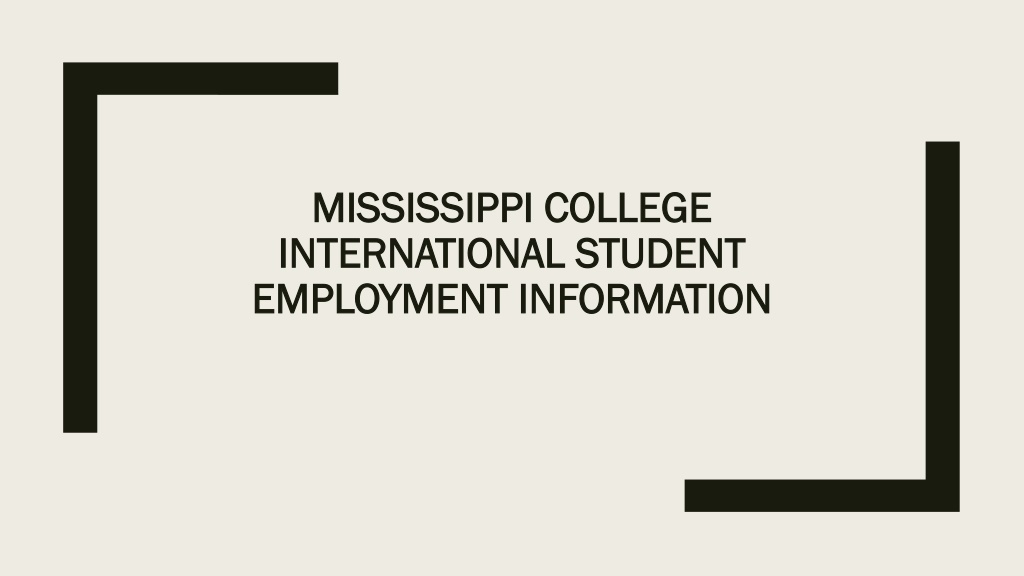
 undefined
undefined

